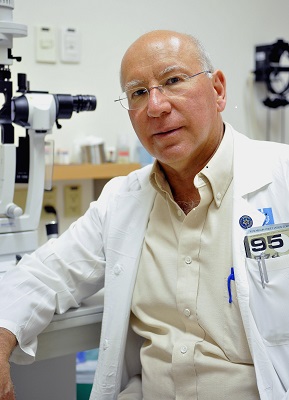
Imagine that it is 1948. Dr. Isaac Caesar Michaelson, who served as an ophthalmic surgeon for the British Eighth Army while its soldiers fought the Nazis in Egypt, immigrates to Israel.
He is asked by the newly created health ministry to set up eye-care services for the new state.
Six years later, in 1954, Prof. Michaelson is named the Director of the Hadassah Medical Center’s Ophthalmology Department.
Under his management, the department becomes the Ophthalmology Research Center–the first department of ophthalmology to include research laboratories. Prof. Michaelson zeroes in on pathological new blood vessel formation in the retina and predicts that there is a protein that is triggering this abnormal vessel growth. He names it “the x-factor.” While this factor was considered essential for the development of the retina’s blood vessels, it could also stimulate the creation of too many vessels in response to a lack of oxygen reaching the retinal tissues and cause various retinal diseases.
Fast forward to 1991. Hadassah Ophthalmologist Prof. Jacob Pe’er (pictured above) is studying ocular cancer. He goes to see Prof. Eli Keshet, a molecular biologist at the Hadassah-Hebrew University Medical School, because he knew the professor was studying the mechanisms of blood vessel formation and the elaborate controls of the main protein that initiates the genesis of new blood vessels. These blood vessels are a most important factor in nourishing cancer cells.
As he listens to Prof. Keshet describe his work, Prof. Pe’er finds that his heart is beginning to race. He urges Prof. Keshet to examine a retinal tissue sample from one of his cancer patients because he suspects that the protein Prof. Keshet is studying is Prof. Michaelson’s x-factor.
Recalling this scenario all these many years later, Prof. Pe’er says, “I couldn’t sleep for three nights until the results came back. Sure enough, we had found the key to Michaelson’s mysterious x-factor. Now a medicine could be developed to treat it and save eyesight.”
That protein is called Vascular Endothelial Growth Factor (VEGF). It is a signal protein that stimulates the formation of blood vessels. With this discovery, the intellectual door was opened for a drug manufacturer named Genentech to develop an antidote for this overproductive VEGF.
Genentech’s Avastin–one of the most widely prescribed medicines today to treat such retinal diseases as age-related macular degeneration, diabetic retinopathy, and central retinal vein occlusion– was the result.
Prof. Pe’er explains, “It’s simple. The key to developing any medication is first identifying the germ or bacteria or, in this case, a protein that is causing the problem. Once we identified the VEGF, the drug company could develop its remedy. Avastin is the ‘anti’ that combats the overproducing VEGF.”
Today, there are a number of “anti-VEGF” drugs being studied to treat a variety of cancers.
